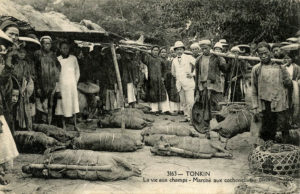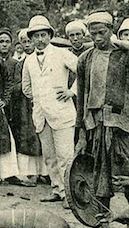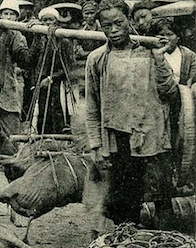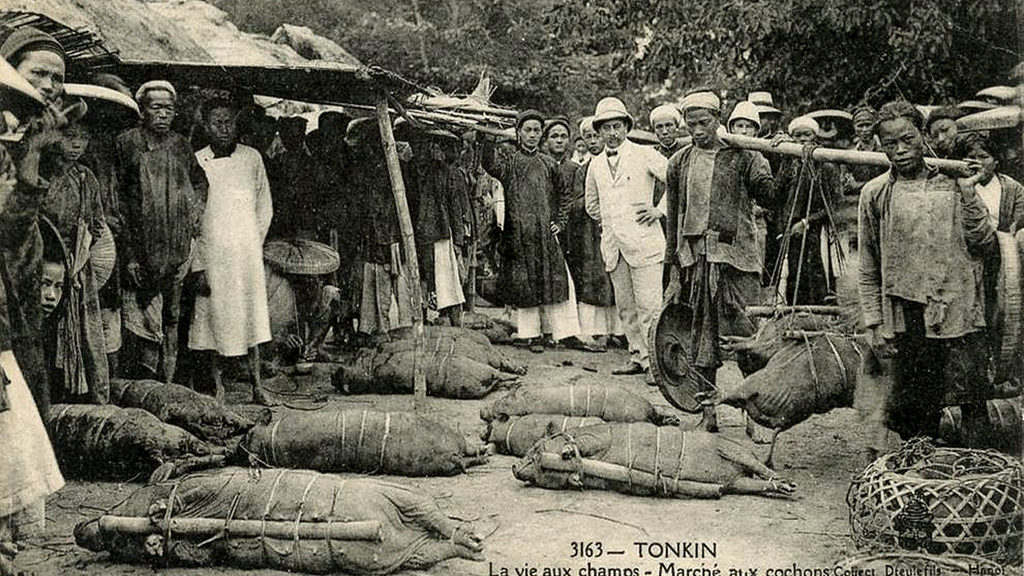 A Description
A Description
To look at an example of colonial justification, I’ll be using this French postcard taken by a Pierre Dieulefils. The exact date of when it was taken is unknown, but it was between 1905 and 1925. The postcards text indicates it was taken in Tonkin, the northern part of Vietnam. The picture shows a crowd of native Vietnamese standing around tied up dead pigs. It appears to be a marketplace. In the middle, a bright man in a white outfit with a black bowtie stands with his hands on his hips. On the bottom right of the postcard, it reads:
“La vie aux champs – Marché aux cochons”
which translates to
“Life in the country – The pig market”
To the right of the text is “Collect. Dieulefils” indicating that the picture is from the collection of Dieulefils.
Contrast in Clothing

The most interesting aspect of this postcard is the contrast in clothing between the man in western clothes and the other Native Vietnamese. This contrast highlights the idea of cultural superiority that any recipient would immediately recognize. It accentuates the cleanliness of the westernized male which simultaneously demeans the integrity of the colonized people. By highlighting this, the colonizer has found another reason to go through with modernization projects other than the exploitation of the country’s resources. Procolonial frenchmen, at the time, called it France’s “civilizing mission” and boasted the establishment of institutes as success. But, in doing so, many natives criticized the French that they were erasing Vietnamese history and culture (Bain, 1967). By 1939, only 15 per cent of Vietnam’s school aged children in school, about 80 per cent of the population was illiterate, and there was only one university with 631 students that served a country of 20 million people (Bain, 1967). The French were not concerned with the wellbeing of the people at the time and only spreading enough education to provide interpreters, clerks, and petty bureaucrats for French businesses.
Contrast in Wealth
Another aspect of this contrast showed the Vietnamese natives to  look much less wealthy than the French man. This gave France a greater reason to attempt and provide more jobs for the people of Vietnam. It may have led to more jobs for the people in Vietnam, but it made for miserable working conditions in urban and rural areas (Bain, 1967). Between 1912 and 1923, actual wages declined and dropped even lower during the depression (Bain, 1967). In 1953, 75
look much less wealthy than the French man. This gave France a greater reason to attempt and provide more jobs for the people of Vietnam. It may have led to more jobs for the people in Vietnam, but it made for miserable working conditions in urban and rural areas (Bain, 1967). Between 1912 and 1923, actual wages declined and dropped even lower during the depression (Bain, 1967). In 1953, 75
percent of the labor employed in Nam Dinh consisted of women and children between the ages of 14 and 18. Boys of about 10 years old were even working in the Tongking anthracite mines (Lancaster, 1961). In the meanwhile, Vietnam, in 1939, was exporting large amounts of raw materials and more prosperous than ever for the French (Bain, 1967).
Poor Rural Communities
This photo also supports the statement that French colonization hardly had any benefits on rural communities. From the photo, it doesn’t seem as if the Vietnamese look any better off since French occupation. As mentioned before, the caption translates to “Life in the country”, and this is a representation of how the rural areas looked like, and indeed, only the the urban elite were influenced the most. 85 percent of the Vietnamese population was relatively unaffected by French occupation (Bain, 1967). In the “Emancipation of French Indochina”, Lancaster (1961) describes the life of a peasant:
“In spite of an ambitious
programme of public works, the peasant continued to farm his land with the traditional agricultural implements, to live in the closed economy of his village, and to use the ancient dust tracks across the deltaic plans.”
The French did, however, provide rural populations with alternative employment on plantations, mines, and cotton mills. The reason for why more economic opportunities weren’t created is because French policies discouraged any industries that would compete with French exports (Miller, 1947).
France may have appeared to be helping the Vietnamese with modernization, education, and industrial projects, but they were exploiting resources and the labor of the Vietnamese people for the profit of their own country.

